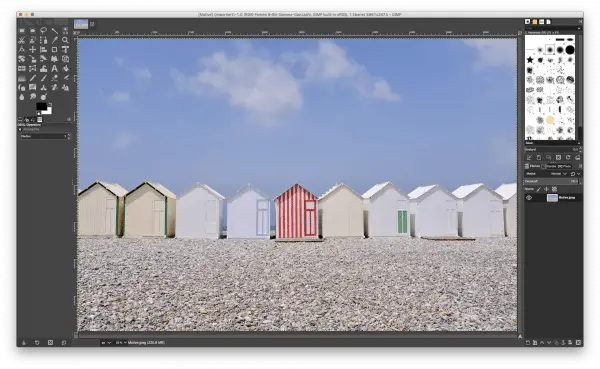When you go on vacation, the anxious question arises year after year whether it makes sense to just take your smartphone or an additional camera with you. Basically, the question can be answered as follows: Additional cameras only make sense where ambitious photography, for example with zoom, is to be used. For everyone else, the smartphone is basically enough, especially since it offers some tangible advantages such as automatic geotagging, spontaneous insta-posting and automatic photo backups in the cloud. However, there are a few small things to consider here.
10 tips for taking better vacation photos with your smartphone
Tip 1: Know your smartphone camera
If you want to do without a "real" camera on vacation, you should first check the technical data of your smartphone . Modern models have at least 12 megapixels, which is quite enough. Most smartphone cameras have light wide-angle lenses, which is ideal for vacation. Zoom is now available on many models that have two cameras. Otherwise, of course, it makes sense to look at everyday recordings before going on vacation: If their quality is sufficient, no additional camera has to be dragged along on vacation.
Tip 2: Proximity is everything
Since most smartphones have wide-angle optics, smartphone photographers should pay particular attention to one thing when on vacation: Proximity! Especially when people are in the picture, it is important to depict them as filling the frame as possible. If the background is also important, you can simply let your partner or children come closer to the camera: The image section of the background remains the same..
 Get close to the subject! Then the pictures effectively show the mood. (Image: Christian Rentrop)
Get close to the subject! Then the pictures effectively show the mood. (Image: Christian Rentrop)
Tip 3:
You are welcome to take a step back as well. Since most smartphone cameras only have a moderate wide angle, it is often difficult to take a meaningful picture of things like churches or other buildings. In addition, the automatic frog's eye view often leads to so-called falling lines, and such photos are boring on top of that. It therefore makes more sense to think for a moment - and take a few steps back. Then the motif fits completely into the picture and the result can be an extremely beautiful photo.
 Taking a step back helps to find better perspectives. (Image: Christian Rentrop)
Taking a step back helps to find better perspectives. (Image: Christian Rentrop) Tip 4: Find an interesting perspective
However, pictures of well-known buildings are standard goods. Buildings like the Atomium, the Taj Mahal or the Eiffel Tower are captured year after year by tourists from all over the world from the same perspective and everyone has seen them a thousand times. For interesting motifs, it makes sense to detach yourself from the tourist grapes and simply change your perspective - this quickly results in completely new views of the same motif, which can also impress at home..
 From a different perspective, the images are often much more interesting - as here at the Brussels Atomium. (Image: Christian Rentrop)
From a different perspective, the images are often much more interesting - as here at the Brussels Atomium. (Image: Christian Rentrop) Tip 5: Find and reproduce
a (light) mood If a place has a certain mood - calm, cold, comfort, restlessness, overcrowding or the like - you should try to reproduce it. This means that you should find the right moment in terms of light and perspective. You can also take strangers into the picture as "garnish" instead of waiting for a moment without passers-by. Images without people often seem boring and hypothermic, especially in long shots, and the eye cannot see any relationships. If people are in the photo, if in doubt, the picture reflects the mood of the place much better and looks more lively overall.
 Without the two people in the picture, this photo of the Elbe would certainly be much less atmospheric. (Image: Christian Rentrop)
Without the two people in the picture, this photo of the Elbe would certainly be much less atmospheric. (Image: Christian Rentrop)
Tip 6: Situations instead of technical perfection In the
evening, many smartphone photographers zoom deeply into their pictures while sorting them out and then mercilessly dispose of these pictures because they are slightly blurred, have blurring or because they are noisy. That doesn't always make sense: some of the best vacation pictures are those that were shot spontaneously "from the hip" and depict a situation without being technically perfect.
 This picture is technically unsuccessful in every respect. Nevertheless, the situation is wonderful and a photo is something that you always enjoy looking at. (Image: Christian Rentrop)
This picture is technically unsuccessful in every respect. Nevertheless, the situation is wonderful and a photo is something that you always enjoy looking at. (Image: Christian Rentrop) Tip 7: Avoid clichés
Even if it makes sense: cliché photos like the boats in Thailand are to be avoided at all times. Instead, keep your eyes peeled for nice everyday situations instead of shooting the same three and a half motifs that everyone brings with them from vacation. In times of absolute travel freedom, you can leave the cliché photos to the travel catalog photographers, they can do it better anyway. Focus your gaze on moments that are typical for your holiday destination - and look forward to the atmospheric pictures for years to come.
 A typical everyday situation in India that offers better memories than any photo of the Taj Mahal. (Image: Christian Rentrop)
A typical everyday situation in India that offers better memories than any photo of the Taj Mahal. (Image: Christian Rentrop) Tip 8: Pay attention to the light and
do without the flash But enough of the choice of subject, now a few technical things: You should avoid the smartphone flash if possible: The small LED flashes spoil the mood of the picture, and they also delay the recording. It is better to use the existing light or to use an additional light source such as a candle or a campfire for the right mood. So always turn off the flash!
 The flash should always be off!
The flash should always be off! Tip 9: Stay away from the digital zoom
Just like the flash, the digital zoom of most smartphone cameras cannot be used. It is best not to use it at all: You can also cut out and enlarge the section with significantly better quality at home on your PC or Mac. Because the digital zoom basically only enlarges the pixels and then places a blur over them. The results are not very nice photos.
 The digital zoom doesn't really help. (Image: Christian Rentrop)
The digital zoom doesn't really help. (Image: Christian Rentrop) Tip 10: Don't delete anything, look at it on the PC and edit it.
Last but not least, a tip to avoid deleting seemingly unsuccessful photos: Modern smartphones usually have enough memory. So you don't have to delete anything. The images on the large PC or Mac screen often look very different from those on the small smartphone display. So take all the pictures home with you and view them in peace on your PC. There is also powerful post-processing here with tools like Gimp. In this way you get some great holiday memories that you would normally have deleted on your smartphone.
 With tools like Gimp you can conveniently view and edit the vacation photos at home.
With tools like Gimp you can conveniently view and edit the vacation photos at home.